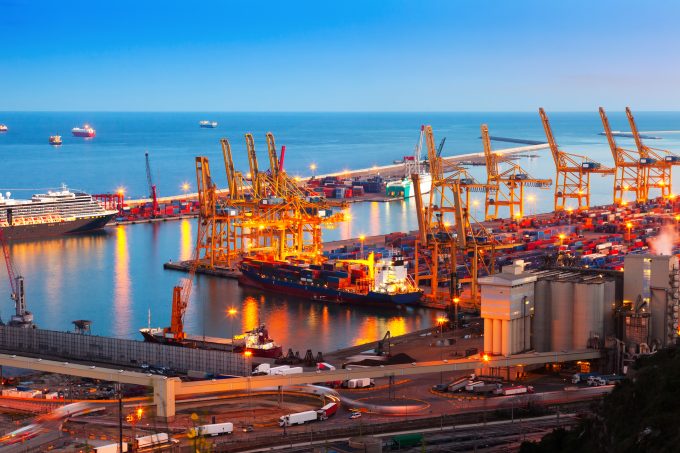Control of Wilson Sons could boost MSC dominance in Brazil
MSC’s acquisition of Brazilian operator Wilson Sons has raised eyebrows among forwarders in the region, ...
GM: RAISING THE ROOF GGM: IN FULL THROTTLE GZIM: MAERSK BOOST KNIN: READ-ACROSSMAERSK: NOT ENOUGHMAERSK: GUIDANCE UPGRADEZIM: ROLLERCOASTERCAT: HEAVY DUTYMAERSK: CATCHING UP PG: DESTOCKING PATTERNSPG: HEALTH CHECKWTC: THE FALLGXO: DEFENSIVE FWRD: RALLYING ON TAKEOVER TALKODFL: STEADY YIELDVW: NEW MODEL NEEDEDWTC: TAKING PROFIT
GM: RAISING THE ROOF GGM: IN FULL THROTTLE GZIM: MAERSK BOOST KNIN: READ-ACROSSMAERSK: NOT ENOUGHMAERSK: GUIDANCE UPGRADEZIM: ROLLERCOASTERCAT: HEAVY DUTYMAERSK: CATCHING UP PG: DESTOCKING PATTERNSPG: HEALTH CHECKWTC: THE FALLGXO: DEFENSIVE FWRD: RALLYING ON TAKEOVER TALKODFL: STEADY YIELDVW: NEW MODEL NEEDEDWTC: TAKING PROFIT

With the demand outlook from Asia to North Europe hobbled by recession fears and Brexit uncertainty, ocean carriers are beginning to look further south for growth.
Container spot rates for Mediterranean ports have shown a greater robustness than North European rates over the past year and, according to the latest reading from the Shanghai Containerized Freight Index (SCFI), are $60 per teu higher than a year ago at $857, whereas North Europe rates are $831 per teu, down from $916 twelve months ago.
As part of their upcoming network reshuffle, as well as to cater for Zim volumes as a result of their ‘strategic cooperation agreement’, 2M partners Maersk Line and MSC are redeploying 11 ultra-large, 19,000 teu vessels from the Asia and North Europe route to the Asia-Mediterranean tradelane.
Alphaliner said the switch would involve the 2M’s AE1/Shogun North Europe loop and its AE11/Jade Mediterranean service, which will see the latter upgraded from 14,000 teu-16,600 teu ships to 18,300-19,400 teu vessels from the end of March.
At the same time, the 2M AE1/Shogun loop will deploy smaller, 13,000-14,000 teu vessels, although as part of its strategy to reduce fuel consumption by slower steaming and its aspiration to improve schedule reliability, the number of ships on the loop will increase from 11 to 16.
Moreover, the AE1/Shogun and AE6/Lion (another Asia-North Europe string) which Alphaliner said is also being downgraded in vessel size, will also include transpacific extensions in the form of new pendulum loops as part of the 2M’s network reshuffle.
The consultant noted that the revised configuration of the AE1/Shogun and AE6/Lion services would make them the smallest of the 2M’s six Asia-North Europe loops.
“Overall 2M weekly capacity on the Asia-North Europe route will be about 6,000 teu, or 6% lower in the second quarter of 2019 compared with the same period last year,” said Alphaliner.
This capacity reduction comes as the rival Ocean Alliance introduces an extra, seventh loop to its revised network in April.
“With the addition of the new Loop 7 product, the increased frequency between Asia and North Europe will allow for greater loading flexibility, confidence on service commitments, as well as room for growth through the extended network coverage,” said Cosco subsidiary OOCL last month.
Drewry said at the time that the Ocean Alliance extra loop was “inevitable”, due to the vast number of ULCV deliveries stemmed for the partners this year.
It noted that Cosco was due to receive 12 19,200-21,200 teu vessels in the first six months of this year, and that between them CMA CGM, Cosco/OOCL and Evergreen were responsible for 62% of the industry’s estimated 460,000 teu of ULCV deliveries stemmed for this year.
“No amount of slow-steaming could hide all that new tonnage,” said Drewry.
Meanwhile, THE Alliance members Hapag-Lloyd, ONE and Yang Ming are also in the process of upsizing their vessels on the Asia-Mediterranean route. From April, Alphaliner said, the VSA grouping would replace the ten 8,100-10,000 teu ships deployed on its Asia-Med MD1 loop with 11 13,500-14,220 teu vessels, including the 14,220 teu Yang Ming newbuild, the YM Warranty.
Comment on this article